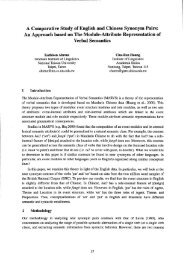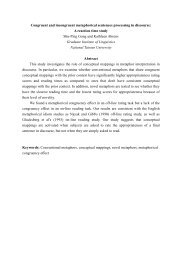The Polysemy of Da3: An ontology-based lexical semantic ... - CWN
The Polysemy of Da3: An ontology-based lexical semantic ... - CWN
The Polysemy of Da3: An ontology-based lexical semantic ... - CWN
You also want an ePaper? Increase the reach of your titles
YUMPU automatically turns print PDFs into web optimized ePapers that Google loves.
One full eyes dream MOD happy girl, because<br />
shou4 shang1 kai1 dao1, yao4 da3 ding1 zi5 jin4 ji2 zhui1, xiang4 fu4<br />
hurt operate, will put nail to spine, like set<br />
yi1 jia4 yi1 ban1 ba3 wan1 wan1 de5 gu3 tou2 cheng1 zhi2.<br />
clothes stand in general let bend MOD bone prop straight.<br />
“A happy girl full <strong>of</strong> dreams due to an injury happened, has to undergo an operation that<br />
puts nails into her spine to straighten up the wiggled spine, which is very similar to<br />
clothing being hanged on hangers.”<br />
We follow these categories to explore the common features for these physical event senses <strong>of</strong><br />
da3 in the SUMO concept system.<br />
7. Data analysis<br />
According to Gao’s study (2001), she <strong>based</strong> on sense division principle to analyze da3,<br />
generalized the patterns and features <strong>of</strong> the polysemy <strong>of</strong> da3, and obtained five major categories.<br />
Gao (2001) mentioned the prototypical meaning <strong>of</strong> da3. She talked about in the prototypical<br />
case the most central part <strong>of</strong> the meaning <strong>of</strong> da3 is the physical contact between an agent’s<br />
hands and a concrete item. In her paper, she also mentioned that there were three different<br />
<strong>semantic</strong> elements for da3 such as 1) hand, hand holdings or instrument; 2) force direction and<br />
3) impact.<br />
From all our senses <strong>of</strong> da3, we can divide two main categories: 1) physical event senses such<br />
as da3 zhuo1 zi5 (to tap the table), da3 shou3 bei4 (to hit the back <strong>of</strong> a hand), ba3 wan3 da3<br />
po4 (to break a bowl)... and so on and 2) metaphorical event senses such as da3 jiao1 dao4 (to<br />
develop the interpersonal relationship/ to come into contact with), da3 dian4 hua4 (to call), da3<br />
ke1 shui4 (to nod)... and so on. However, in this study, we just focus on physical event senses.<br />
Based on Gao’s analysis (2001), we know that physical event senses <strong>of</strong> da3 include these<br />
features such as hand, hand holdings, instrument; force and impact, so we thoroughly examine<br />
our physical event senses by SUMO concept system. In here, we can observe that there are<br />
several concept <strong>of</strong> SUMO for physical event senses <strong>of</strong> da3 such as below table:<br />
Table 2: SUMO concept for physical event senses <strong>of</strong> da3<br />
<strong>The</strong> phrase <strong>of</strong> da3 in Chinese Translation in English SUMO concept<br />
da3 shou3 bei4 to hit the back <strong>of</strong> a hand impacting<br />
da3 zhuo1 zi5 to tap the table touching<br />
ba3 wan3 da3 po4 to break a bowl impacting<br />
lun4 tai1 da3 qi4 to pump gas into tire putting<br />
da3 shi1 li4 kang1 to inject silicon putting<br />
We follow SUMO concept system to obtain these concepts <strong>of</strong> da3. <strong>The</strong>se concepts are such as<br />
impacting, touching, putting. We also know that the SUMO concept identifications correspond<br />
with the divisions and definitions in WordNet. For this reason, we need make sure the WordNet<br />
definitions <strong>of</strong> these concepts for physical event senses <strong>of</strong> da3.<br />
Table 3: WordNet definition and SUMO concept for physical event senses <strong>of</strong> da3<br />
<strong>The</strong> English WordNet definition<br />
SUMO<br />
lemma <strong>of</strong> da3<br />
concept<br />
hit<br />
deal a blow to, either with the hand or with an impacting<br />
160






